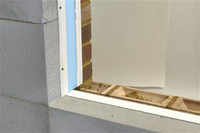Jul 14 2010
<h2>While placing an overall target of 25% reduction in carbon emissions from new buildings, the 2010 revisions to Part L also focus very clear attention on the U value of external walls.
</h2>
<p>The new specified limiting U value is now 0.30 W/m2K, down from 0.35, although in practice the actual U value required will probably be much less at around 0.20 – 0.25W/m2. While challenging, this can still be easily met with current cavity building methods while solid wall construction and external insulating render is a viable alternative for lower U values.</p>
<p>

</p>
<p>However, the really big headache for building designers lies in the changes to the SAP calculations and their impact on the issue of thermal bridging.</p>
<p>Under the old SAP 2005, the additional heat loss through thermal bridging was dealt with by a simple mathematical formula. This multiplied the total exposed area by a single factor “Y”, applicable to all dwelling types. This was then added to the other heat losses through the building fabric. For junctions conforming to the Accredited Construction Details (including masonry and timber frame structures) the global Y value was taken to be 0.08.</p>
<p>However, the Y value could be reduced to 0.04 if the more thermally efficient <a href="
http://www.hhcelcon.co.uk" target="_blank">H+H</a> aircrete was used in the standard Accredited Construction Details. Alternatively, for aggregate blocks or lightweight framing systems, Enhanced Construction Details would have to be adopted (which require additional costly insulation at specific junctions). The effect of the reduced Y is a significant reduction of CO2 emissions (a saving which is equivalent to reducing the U-values of every external element by 0.04W/m2K). </p>
<p>From October, however, this simple mathematical formula will no longer be acceptable. Instead, the use of SAP 2009 will mean that the simple global Y value is substituted by a dwelling specific Y value, which must be calculated individually for each dwelling, based on the lengths of each thermal bridge multiplied by the heat loss factor, Ψ, associated with the junction detail.</p>
<p>Whilst it forces building designers to consider the Ψ value of each junction in an individual building. This new calculation method does not alter the advantageous position of aircrete, which will still give half the heat loss at junctions when compared to other forms of construction. </p>
<p>H+H, through the Aircrete Products Association has produced a series of design details, illustrating working examples of typical junctions and the relevant Ψ values that designers can use to calculate heat losses.</p>
<P><font size="1">Posted 13th July 2010</font></p>